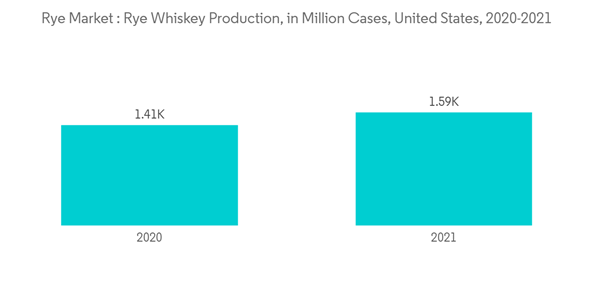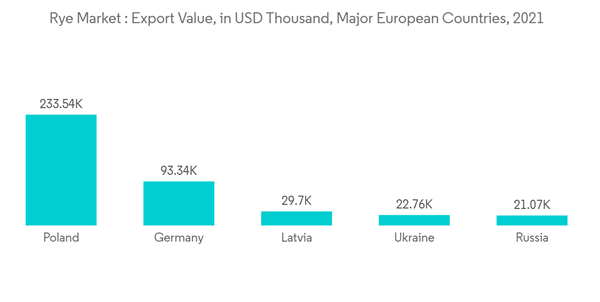Key Highlights
- Rye is a good source of vitamin B6, thiamine, niacin, iron, folate, fiber, and riboflavin. Rye also contains small amounts of zinc, pantothenic acid, phosphorus, magnesium, calcium, and other micronutrients. Rye can improve heart health, aid blood sugar control, assist digestive health, reduce inflammations, and reduce the risk of several cancers.
- According to the Food and Agriculture Organization (FAO), Germany, Poland, Russia, Belarus, Denmark, Ukraine, and China are the major producer of rye across the globe contributing 3,325.6 thousand metric tons, followed by 2,472.8 thousand metric tons, 1,721.9 thousand metric tons, 845 thousand metric tons, 672.4 thousand metric tons, 593.1 thousand metric tons, and 512.2 thousand metric tons during the year 2021.
- Rye is the most important crop in most European countries. Rye is a comparatively modern crop with production majorly in Northern Europe. Rye plays a very important role in countries with poor-quality soil and can also handle colder temperatures compared to other grains. The increase in demand in the food and beverage processing industry is driving its market growth during the forecast period.
- Rye whiskey derives its unique spicy and flavorful characteristics from the complexity of the grain. Some newer hybrids, like Abruzzese Rye, Danko Rye, and Brasetto Rye used by distillers, brewers, and bakers, are being tested especially for climate and soil conditions by Universities in the region like Penn State. These varieties are also commonly used as cover crops.
Rye Market Trends
Rise in Demand from the Food and Beverage Processing Industry
- Rye is commonly consumed in northern and eastern Europe as its energy, and micronutrient content is similar to other cereals. However, it is consumed mostly as whole-grain bread as it has considerable dietary fiber. Rye products play a central role in the Finnish diet. Rye grain is used for flour, bread, beer, crispbread, whiskeys, vodkas, and animal fodder. It can also be eaten whole, as boiled rye berries, or rolled, similar to rolled oats.
- In Russia, the consumption of rye is popularly found in a traditional fermented drink known as Kvass, which is made by brewing rye bread and sugar. It is mostly consumed in the summertime and has very low alcohol content. The increase in demand from the food and beverage processing industry is driving the market growth for rye during the forecast period.
- Rye is popular in Eastern Europe, with most of the world's crops grown in Russia, Poland, and Germany. Many common food and beverages contain rye, including bread, crackers, beer, and whiskey. Rye berries can also be eaten whole, rolled into flakes, and eaten as cereal. Rye bread can be made with light or dark rye flour. Light rye flour has a tan or taupe color, and light flavor, containing only a small amount of the rye berry's outer bran shell. In the United States, rye whiskey refers to whiskey that has been distilled using at least 51 percent rye (the remainder of which comprises corn and barley).
Europe Dominates the Market
- Rye is grown primarily in Eastern, Central, and Northern Europe. The main rye belt stretches from northern Germany through Poland, Ukraine, Belarus, Lithuania, and Latvia into central and northern Russia. Germany and Poland are the main producing and consuming countries for rye in Europe.
- Around half of the produced rye is used in animal feeds. The increased demand for rye in alcohol production has further stimulated its consumption demand within the region during the forecast period.
- This crop's yield remained high, allowing EU countries to trade rye with other countries. According to Euro statistics, domestic prices in the EU have become lower so that this crop can be exported. Domestic prices for rye in the EU are highly dependent on the cost of corn. The main suppliers of this crop are Latvia, Estonia, and Poland.
- However, high rye yields are traditionally observed in Germany (up to 3500 thousand tons in 2020) and Denmark (up to 725 thousand tons in 2020). As per the Food and Agriculture Organization (FAO), the total area harvested in Russia accounted for 998.8 thousand hectares, followed by Poland with 761.6 thousand hectares, and Germany with 631.0 thousand hectares, which will further propel market growth in coming years.
Additional Benefits:
- The market estimate (ME) sheet in Excel format
- 3 months of analyst support
This product will be delivered within 2 business days.
Table of Contents
Methodology

LOADING...










